
2013 Clos-St-Denis, Grand Cru, Vieilles Vignes, Dominique Laurent, Burgundy

About this WINE

Domaine Laurent
Domaine Laurent in Burgundy is managed by former pâtissier Dominique Laurent, who produces exemplary wines from his small négociant business located in Nuits-St-Georges. He sources fruit from very old parcels and his offerings range up and down the Cote d'Or, with dozens and dozens of different appellations often offered in minuscule quantities of 25 or 50 cases of wine.
The first vintage was 1988 and his reputation rapidly grew for expensive, handcrafted red Burgundy. His two initial inspirations were an old-fashioned vigneron in Beaune and then the controversial oenologist Guy Accad. Between these two he came to develop his own idiosyncratic thoughts about the way to make fine wine. He advertised the brand as Dom Laurent, a deliberate confusion between his first name and an abbreviation of domaine, which of course was not accurate for his merchant status. But the most recent development is the establishment with his son Jean of Domaine Laurent Père & Fils, currently 6 hectares including Meursault Poruzots and Nuits St Georges, with three more hectares about to follow.
It was soon clear to Dominique Laurent that the quality of the barrel was paramount, so the next logical step was to make his own! He works only with Tronçais wood, selected himself, and air-dried for at least three (and up to seven) years. Because of the costs involved in setting up a cooperage, he makes more barrels than he requires for his own wines, selling what he does not need himself to a limited number of Burgundy domaines and to various overseas producers.
Much comment, not necessarily favourable, was made of his early habit of using 200% new oak – i.e. racking out of one new barrel into another brand new one. Dominique felt that only new wood gave the sense of fat that he is looking for in top pinot noir. Since he has had his own barrels the need is not so great for new oak because his long air-dried Tronçais wood retains its qualities for more than one wine.
So the gospel according to Dominique is this: find plots of ancient vines in the best parts of interesting vineyards, in the hands of vignerons who know what they are doing. The wine is delivered early in the New Year from the producer who has vinified it (albeit sometimes under his instruction). It may then be transferred to new barrels – not racked, please, because it is essential to keep all the lees and gas from the original barrel – and aged without addition of sulphur until ready for bottling.
A barrel tasting of 2008s showed plenty of difference between one wine and another, no undue influence of new oak, and some wines of fine quality – notably an Echezeaux and a Chambertin Clos de Bèze.
Laurent's skill in seeeking out fabulous examples of each appellation has certainly been the engine that has driven Laurent's top quality train.
Jasper Morris MW, Burgundy Wine Director and author of the award-winning Inside Burgundy comprehensive handbook.

Chambolle Musigny
Chambolle produces the most elegant wines in the Côte de Nuits, having more active chalk and less clay in the soil than the other villages. The wines may be a little lighter in colour and less tannic than Gevrey-Chambertin but they have a sublime concentration of fruit. Village Chambolle-Musigny usually provides excellent value.
Le Musigny is one of the top half-dozen vineyards in Burgundy, producing wines of extraordinary intensity and yet with a magical velvety character. Les Amoureuses is immediately appealing, a wonderfully sensual wine which deserves Grand Cru status. Bonnes Mares tends to have a firmer structure and ages very well
- 94 hectares of village Chambolle-Musigny.
- 61 hectares of Premier Cru vineyards (24 in all). The finest vineyards include Les Amoureuses, Les Charmes, Les Fuées, Les Baudes and Sentiers.
- 24 hectares of Grand Cru vineyard - Bonnes Mares and Le Musigny.
- Recommended producers: de Vogüé, Mugnier, Roumier, Barthod.
- Recommended restaurant: Le Chambolle

Pinot Noir
Pinot Noir is probably the most frustrating, and at times infuriating, wine grape in the world. However when it is successful, it can produce some of the most sublime wines known to man. This thin-skinned grape which grows in small, tight bunches performs well on well-drained, deepish limestone based subsoils as are found on Burgundy's Côte d'Or.
Pinot Noir is more susceptible than other varieties to over cropping - concentration and varietal character disappear rapidly if yields are excessive and yields as little as 25hl/ha are the norm for some climats of the Côte d`Or.
Because of the thinness of the skins, Pinot Noir wines are lighter in colour, body and tannins. However the best wines have grip, complexity and an intensity of fruit seldom found in wine from other grapes. Young Pinot Noir can smell almost sweet, redolent with freshly crushed raspberries, cherries and redcurrants. When mature, the best wines develop a sensuous, silky mouth feel with the fruit flavours deepening and gamey "sous-bois" nuances emerging.
The best examples are still found in Burgundy, although Pinot Noir`s key role in Champagne should not be forgotten. It is grown throughout the world with notable success in the Carneros and Russian River Valley districts of California, and the Martinborough and Central Otago regions of New Zealand.


Buying options
Add to wishlist
wine at a glance
Delivery and quality guarantee